Definitions:
- SLEEP
- reversible behavioural state of unresponsiveness & perpetual dissociation from the environment
- CONSCIOUSNESS:
- Perception of sensations, voluntary initiation & control of movement, capabilities associated with higher mental processing
Stages of consciousness
_____________________________________________________________________
Sleep
- Not a period of absolute rest
- some parts of the brain are more active during sleep
- Dreams
- necessary
- Experiments where people have been awakened as they enter the REM sleep phase become moody & depressed, and disoriented; and may have hallucinations
- Purpose of sleeping
- Restorative
- especially slow wave sleep
- Conservation of energy
- Maintaining adequate function of the immune system
- Mentally practise & refine behaviour
- e.g. escaping from predators without actually having to perform them
- REM sleep
- we dream to forget
- reverse learning helps us forget trivial things
- and to sort out our emotions
- Physiological changes in sleep
- Decreased reaction to external stimuli
- Reduced activity of the sympathetic system
- Parasympathetic dominance
- Reduced heart rate, BP, respiratory rate
- especially in Non-REM sleep
- Reduced metabolic rate
- Somnolent Metabolic Rate (SMR)
- is lower than BMR
- Reduced muscle tone
- Extensor Babinski response
- unmasking of extensor dominance
- Changes in EEG
- Increased growth hormone production during deep sleep
- decreased in REM sleep
Sleep cycles
- First cycle:
- descends from stage 1-2-3-4
- resurfaces from 3-2-1
- enters REM-descends intom2-3-4 and so on
- Subsequent cycles become shorter
- The cycle ends with REM sleep
- In adults, sleep begins with NREM
- in infants it begins with REM
- REM-onset sleep is seen in adults in
- jet lag
- chronic sleep deprivation
- acute withdrawal of REM-suppressing drugs
- endogenous depressinarcolepsyon
- Retrograde amnesia
- poor recall of midnight dreams
- not remembering clock ringing
- Awake
- Alert
- Beta wave
- Resting
- Alpha wave
- Sleep
- Stage 1
- Theta wave
- Stage 2
- Spindles
- K complex
- Stage 3
- Delta wave appears
- Stage 4
- Delta wave
- Also seen in deep sleep/ anaesthesia / brain damage in awake adults
- Synchronisation
- REM Sleep
- Ponto-geniculo-occipital (PGO) spike
Difference between deep sleep and REM sleep
Changes in pattern of sleep with age
- With age
- REM sleep decreases
- deep sleep decreases
- Total sleep time decreases
Regulation of sleep
- Sleep is regulated by
- an interaction of homeostatic and circadian processes
- The homeostatic mechanisms
- keep track of how long we have been awake and asleep
- how tired we are!
- The circadian process
- determines the optimal time for sleep
- They influence sleep duration and the relative contribution of the two major types of sleep:
- non-rapid eye movement (NREM)
- rapid eye movement (REM) sleep
The circadian process
- Circa=about , dian=day
- The suprachiasmatic nucleus (SCN) dictates the sleep-wake cycles over a roughly 24-hour period
- the SCN receives inputs
via the retino-hypothalamic fibres - is influenced by external cues (e.g daylight)
- but the rhythm is still present in volunteers kept in caves or in people blind from birth
- Light initiates sleep in nocturnal animals & waking in diurnal animals (including humans)
- Melatonin & melanopsin may play a role
- Phase shifts can occur with rapid crossing of time zones
- resulting in ‘jet lag’
The ultradian process
- that is characterized by the alternation of the two basic sleep states non-rapid-eye-movement (NREM) sleep and REM sleep
- influenced by SCN input
- Nucleus reticularis pontis oralis – have 4 nuclei
- PGO-on
- causes PGO spikes associated with REM sleep
- REM-on (stimulatory)
- atonia of muscles during REM sleep
- REM-on (inhibitory)
- inhibits the 2 nuclei inhibiting PGO-on
- REM-waking on
- eye movements
- muscle twitches
- Hypothalamus – have 1 nuclei
- NREM-on
_____________________________________________________________________
Sleep disorders
- Transient relief with “sleeping pills”
- benzodiazepines
- but daytime performance may be compromised
Insomnia
- Definition
- chronic inability to maintain the amount/quality of sleep to function normally in the day
- due to medical or mental conditions
- Right amount of sleep
- sleep requirements vary from 4-9 hours between individuals
- Margaret Thatcher & Napoleon need(ed) only 4 hours of sleep
- Fatal familial insomnia
- autosomal dominant inheritance
- Features
- worsening insomnia
- impaired ANS & motor functions
- dementia
- death
- Types of insomnia
- Onset sleep insomnia
- difficulty in falling asleep initially
- associated with anxiety disorders
- Maintenance sleep insomnia
- wake up middle of the night
- difficulty in remaining asleep
- with frequent awakening at night
- may get back to sleep
- associated with
- pain disorders
- medical illness
- Terminal (late) insomnia
- persistent early morning awakening
- cannot get back to sleep
- characteristic of clinical depression
Sleep deprivation
- Marked by brief psychosis but non-permanent psychological effects
- Features
- irritability
- stimuli misperception
- decreased waking alpha activity
- disorientation
- lack of attentiveness
- Neurological consequences
- tremors
- seizures
Narcolepsy
- Definition
- a chronic neurological disorder caused by the brain’s inability to regulate sleep-wake cycles normally
- excessive daytime sleepiness (EDS)
- Narcolepsy results from
- disease processes affecting brain mechanisms that regulate REM sleep
- For normal sleepers a typical sleep cycle is about 100 – 110 minutes long, beginning with NREM sleep and transitioning to REM sleep after 80 – 100 minutes
- But, people with narcolepsy frequently enter REM sleep within a few minutes of falling asleep
- Three other major symptoms frequently characterize narcolepsy
- Cataplexy
- the sudden loss of voluntary muscle tone
- Vivid hallucinations
- during sleep onset or upon awakening
- Brief episodes of total paralysis
- at the beginning or end of sleep
Somnambulism (sleep walking)
- more common in
- children
- males
- may last a few minutes
- walk with eyes open
- to avoid collision
- but cannot remember anything
- Occur during arousal from slow wave sleep
- somnambulism
- noctural aneuresis
- bed-wetting
- night terrors
- Nocturnal emission
- Wet-dreams
- normal in male (sometimes females) of reproductive age
Sleep apnoea
- Definition
- stopping of breathing for short periods
- typically between 10 and 90 seconds) during a normal nightly sleep
- Can be repeated hundreds of times during a sleep period
- Almost always accompanied by
- snoring, which is usually quite loud
- Patient is unaware of this happening, in normal circumstances
- 3 types of sleep apnoea
- Obstructive sleep apnoea (OSA)
- Fairly common
- upper airway collapses as the throat muscles relax during normal sleep
- cerebral hypoxia results in waking up
- may be repeated every 15 minutes
- May result in
- excessive daytime tiredness and a lack of concentration
- Counter-measure
- Relieve the obstruction
- sleep on the side; reduce weight
- Rare
- Neurological dysfunction
- the brain simply "forgets" or "delays" to send the signal to breathe
- More difficult to treat
- some drugs may help
- Extremely rare
_____________________________________________________________________
Reticular Activating System (RAS)
- The reticular formation resides in the brain stem
- midbrain, pons & medulla
- Comprised of the
- motor system (reticulospinal system)
- sensory systems (RAS)
- the vital centres
- The RAS stimulates the whole brain to cause arousal (wakefulness)
- its output is suppressed
in sleep & coma - stimulated by
- input from the cortex (corticofugal fibres)
- OREXINS
- peptides released by hypothalamic neurons just before waking
_____________________________________________________________________
Consciousness
- Various definitions
- mind
- awareness
- ability to respond
- Can it be equated to activity in the EEG?
- Sometimes, people under general anaesthesia feel the pain and are conscious of their surroundings
- but cannot convey this to the outside world , trapped in their own body
- Perception of sensations, voluntary initiation & control of movement, capabilities –> associated with higher mental processing
- The brain’s ability to adjust its activity and consciousness levels can be impaired in several ways:
- When people are severely deprived of sleep
- When and immediately after a seizure occurs
- When both cerebral hemispheres are suddenly and severely damaged
- When the reticular activating system malfunctions
- When blood flow or the amount of nutrients (such as oxygen or sugar) going to the brain decrease
- When toxic substances impair the brain (liver & kidney failure)
- Drugs
- morphine
- diazepam
- antipsychotic drugs
- Periods of impaired consciousness can be short or long. The level of impairment can range from slight to severe:
- Lethargy
- slight reduction in alertness or clouding of consciousness
- People tend to be less aware of what is happening around them and to think more slowly
- Obtundation
- moderate reduction in alertness or clouding of consciousness
- Stupor
- excessively long or deep sleep-like state
- A person can be aroused from it only briefly by vigorous stimulation
- such as repeated shaking, loud calling, pinching, or sticking with a pin.
- Coma
- state of complete unresponsiveness
- A person cannot be aroused at all
- A person in a deep coma lacks even the most basic responses, such as avoidance of pain
- although reflexes may be present
Coma
(read coma lecture notes)
- In coma, brain oxygen utilisation is below normal resting levels
- in sleep, the brain is active and oxygen consumption is comparable to the waking state
- Caused by
- trauma
- tumours
- metabolic disorders
- hypoglycaemia (hyperosmolar coma)
- drug overdose
- liver and kidney failure
- fluids & electrolytes imbalance
- hypernatraemia
- hypokalaemia
- water intoxication
- myxoedema
- Depression of the reticular activating system (RAS)
- Clinically assessed using Glasgow Coma Scale (GCS)
- Four Score Coma Scale
- eye & motor responses
- brain stem reflexes
- respiration.
Total unresponsiveness to sensory stimuli for an extended period



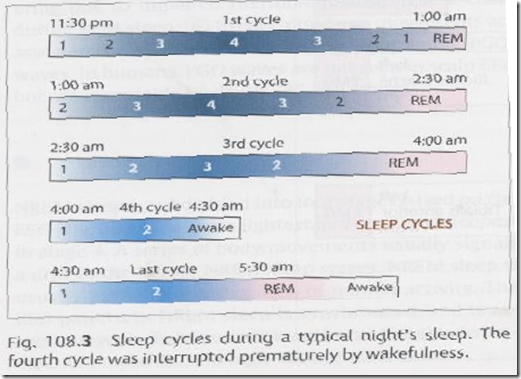
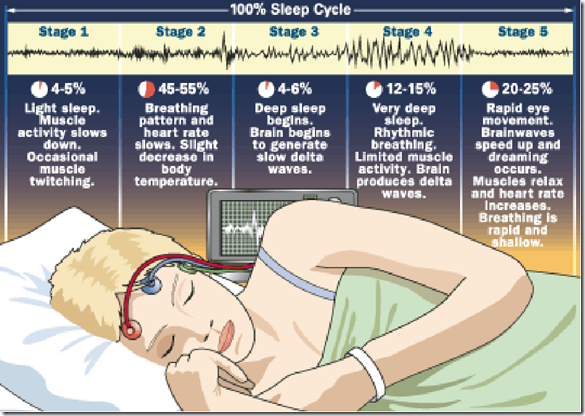
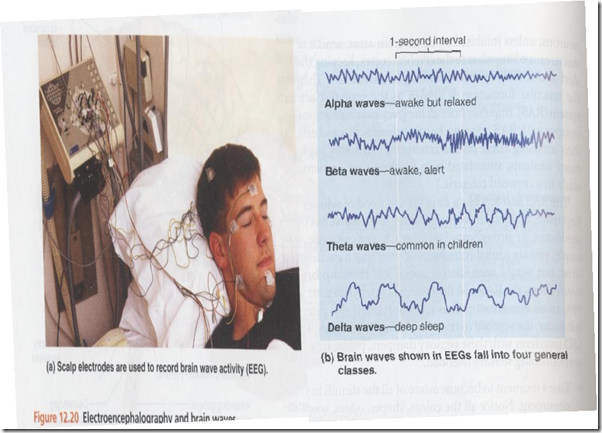
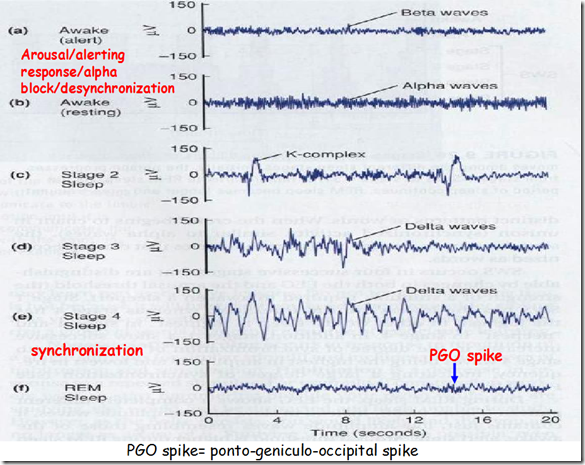
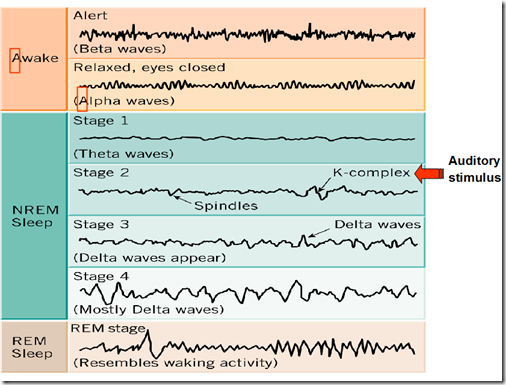
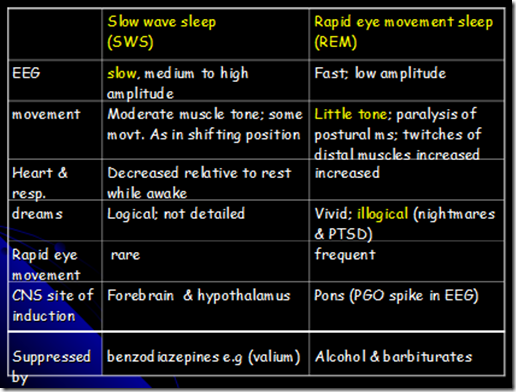

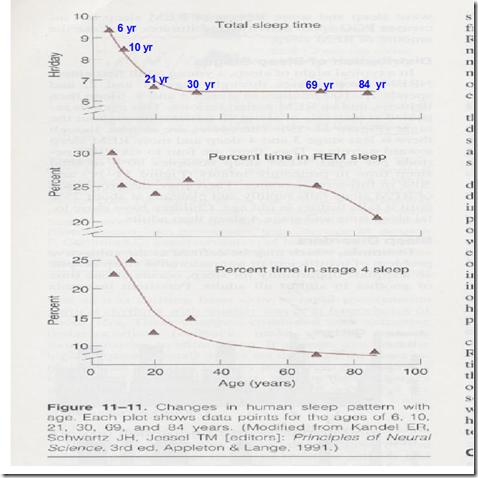
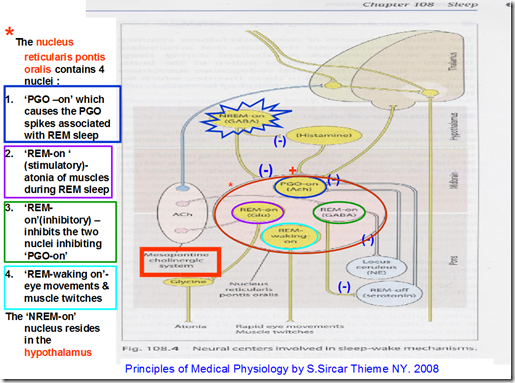
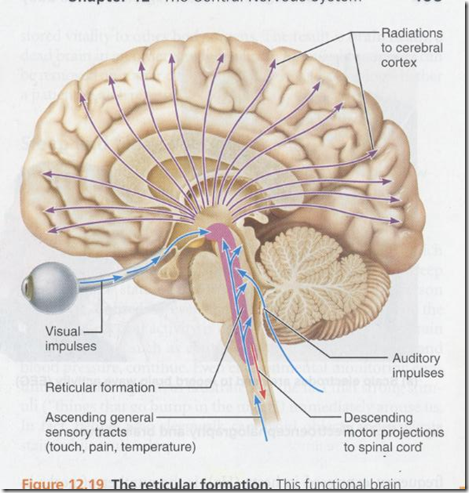
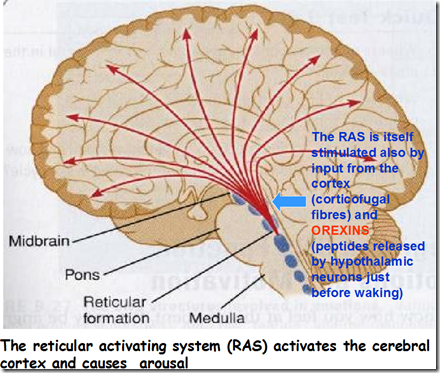
thanks for this info..i have learn a lot.,